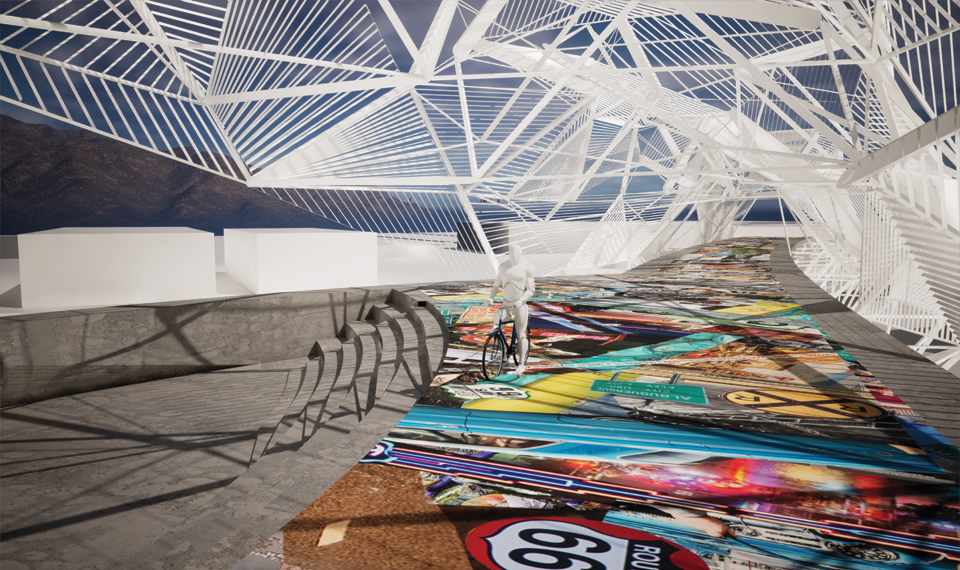RAIL TRAIL Albuquerque, New Mexico Under Construction 2024 The Rail Trail is an episodic, 8 mile-urban multi-modal loop circling the heart of Albuquerque. The Trail crosses historic Route 66 and the alignment of El Camino Real. Located along a portion of the existing railroad corridor, it passes through many of the dynamic entities that Albuquerque encompasses. "Auras" identify and celebrate the dynamic entities and identities intersected by the Trail and Hotspots. Aura is a sweeping cinematic intention from the deepest history to the imagined future. Aura, derived from Latin and Greek meaning wind, breeze or breath, contain the Hotspots where pavement graphics evocatively abstract the mythology and spirit of the Land of Enchantment that makes Albuquerque so special, making us feel grounded in this place. QR codes connect participants to a website featuring deeper historical and visual content.
ELECTRIC TUMBLEWEED an iconic new landmark for Albuquerque. Blown in this altiplano. Coming to rest at the mythic crossroads of Route 66 and the Santa Fe Railroad. Intersecting trajectories of movement—visible to passing Amtrak and Railrunner passengers, to those coming downhill from UNM or looking east from downtown. A reconfiguration to bring pedestrians up from the skanky dank underpass to greater visibility and safety crossing at grade. Reconnecting the Huning Highlands/EDO neighborhood to Downtown, severed since the construction of the Underpass in 1935. Festive and electrified tentacles of light, reflecting off freshly waxed low riders as they cruise below—Obviously, one of New Mexico's top selfie stops as TOE passes through the Tumbleweed. This is the epicenter of Southwest myth-making: crossroads of the Santa Fe Railway and Route 66. To the Southwest, today's transit center recreates the 1902, Mission style Alvarado Hotel, largest of the Fred Harvey Houses.
ENCHANTMENT PLAZA Enchantment Plaza is an elevated platform-bleacher-assembly area attached to the Trail of Enchantment—A visceral connection to the panorama of enchantment. A new gathering place to energize and breathe new life into this rail/warehouse district. An exciting, kinetic experience for cyclists as they ascend the curving path into the cloud like shaded realm to an amphitheater opening out to the Sandia Mountains. A notably different interactive zone unfolds as you drop down to the ground plane. A vibrant commercial world of sidewalk cafes, pop ups, retail spaces, beer gardens and the like, inserted into the segmented bays beneath the structural armature proportioned to house reused shipping containers surrounded by generous shaded gathering spaces. And what will motorists, passing under the Trail, and cyclists above, make of its white lattice amrature? Will it evoke a futuristic ruin of an alien birds wing, fractured feathers frozen in time? Nestled under the enigmatic tree canopy with giant gnarled branches, or a desiccated spinal column of some 1960s sci-fi monster above?
AURA OF UMBRAL HOTSPOT Umbral, Spanish for threshold. The threshold of a door. Figuratively, entrada, an entry point. A beginning. A passage between different worlds. A powerful place of contact and cultural exchange. The place where the Camino Real that connected Mexico City and Santa Fe forded the Rio Grande, and where the later Barelas Bridge carried Route 66 traffic between Chicago and Los Angeles. Umbral imagines in graphic form the far flung Spanish diaspora and is celebrated on the site of the National Hispainc Cultural Center which was adapted from a plan we designed in 1993.
AURA OF IRON HORSE The open arms of the Alvarado Hotel offered a welcoming sight for weary travelers, as Judy Garland sang in the 1946 film, The Harvey Girls, "'Cause lots o' them been travelin' for quite a spell; All the way from Philadelphiay; On the Atchison, Topeka and the Santa Fe." Indeed, the arrival of the Santa Fe Railroad in 1881 transformed Albuquerque from a collection of farming villages into the leading city in the state, passing the population of Santa Fe by 1890, and tripling it by 1940. The roundhouse, since demolished, and the monumental 1921-23 Locomotive Shops—one of only four on the AT&SF—employed over 1,000 workers, drawn largely from the Barelas neighborhood. The use of a limited number of standardized parts in the construction of the shops, like the integration of its steel I-beam structure, glass curtain walls and overhead traveling cranes into a unified, state-of-the-art industrial design made it the equal of any factory in the world.
|
| PROJECTS | TEACHING | CONTACT |













